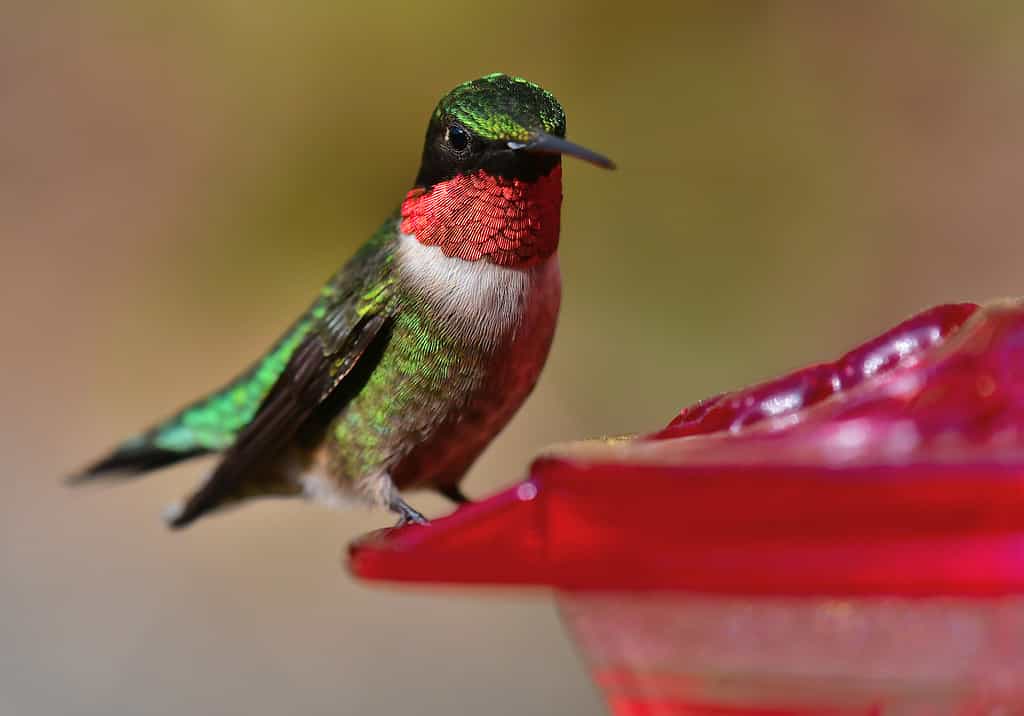Snow melting, flowers budding, and longer daytime hours are some of the first signs of spring. However, the return of birds from their migration is one of the most precious signs of all that the winter is finally over. Among them are hummingbirds, who will return to Illinois when temperatures up north start to rise. But when can residents expect to see them in their backyards and gardens once more? Let’s discuss when hummingbirds will return to Illinois and explore methods locals can use to attract them to their homes.
Hummingbirds in Illinois: A Brief Overview

Ruby-throated hummingbirds usually live to be about 10 years old.
©Robert Winkler/iStock via Getty Images
While some states are home to a wide variety of hummingbird species, Illinois only has a handful of yearly visitors. The most prolific hummingbird in this state is the ruby-throated hummingbird. As its name suggests, these birds are easily identified by the characteristic red patch of feathers on their neck. However, only males of this species will display this trait, as females are more muted in color. Another hummingbird Illinois residents might see during the warmer months is the Rufous hummingbird. These birds are orange and gold in color and they are slightly less common than the ruby-throated hummingbird. Nearly all hummingbirds are most active around dawn and dusk each day, which are popular feeding times. This video from the YouTube channel Birds of Illinois captured some up-close footage of these amazing birds:
When Will Hummingbirds Return to Illinois?

Because they metabolize their food quickly, hummingbirds must eat every few hours to maintain their body weight.
©Keneva Photography/Shutterstock.com
After a cold, long winter, the return of hummingbirds lets many people know that the colder months are finally behind them. Hummingbirds will begin returning to the state of Illinois beginning in late spring. You can expect to see some of them flying around during April, but a majority of hummingbird populations won’t be around until May. Luckily, these birds will stick around all throughout summer into the early fall. Typically, they won’t begin migrating back down to South America until around mid-October, so Illinois locals will be able to enjoy their presence for months on end.
Individuals looking to attract hummingbirds to their backyard should begin putting their feeders out starting in early April. These birds are creatures of habit, and many of them will visit the same few feeders throughout the entire season. Putting your feeders out early will help ensure that your home is one of their primary stops throughout the day. While setting up feeders is a wonderful method to attract hummingbirds to your home, gardeners can consider incorporating plants that help attract insects that hummingbirds like to consume. According to the University of Illinois, “Hummingbirds also need insects in their diet! Planting yarrow, milkweed, and plants with clustered flowers often attract ants and other small insects that they can eat.” In addition, the color red seems to be a favorite among hummingbirds, so red-colored flowers and decor will help catch their eye.
Final Thoughts
Although hummingbirds only visit Illinois for a few short months, they brighten up the lives of many locals. Residents can begin looking for hummingbirds beginning in April, and by May, these birds will be widespread throughout this state.
Thank you for reading! Have some feedback for us? Contact the AZ Animals editorial team.







